I was wrong—well partly wrong! And I’m happy to say so, because it involves sharing some pleasant news.
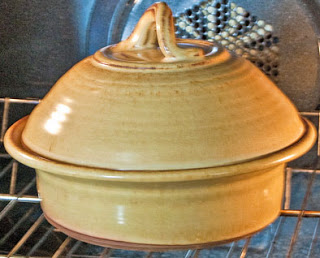 While my concerns were justified (some ceramic containers can’t tolerate such treatment), others, like the beautiful stoneware piece shown here will handle it just fine. In fact, as this pot’s makers Tom and Betsy of Clay Coyote explained, it was custom-created just for baking rustic, crusty pot boules like the one here.
While my concerns were justified (some ceramic containers can’t tolerate such treatment), others, like the beautiful stoneware piece shown here will handle it just fine. In fact, as this pot’s makers Tom and Betsy of Clay Coyote explained, it was custom-created just for baking rustic, crusty pot boules like the one here.
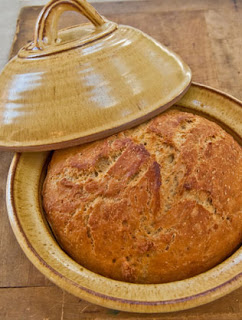 |
| Clay Coyote Stoneware Pot & “Kneadkess” Boule |
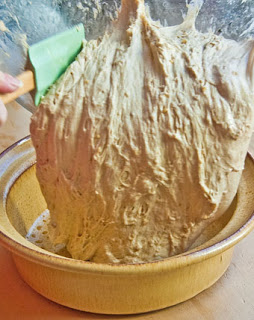
Aside from the obvious aesthetic appeal of baking homemade bread in a hand-crafted pot, I found it produces a loaf with a really beautiful golden color and pleasing crispy crust. I was surprised to find that it is also a more efficient baker than most of the metal pots I’ve tried. While it’s usually necessary to remove the lid after about 50 minutes and allow the loaf to brown and bake a few minutes more uncovered in a metal pot, when I lifted off the lid the loaf was already well- browned, fully baked, and ready to remove from the oven.
With that incredible smell wafting up I could hardly wait to cut some slices! (They are nice served right in the pot.) The pot is also convenient for storing the bread once both are cooled or for reheating the boule again.
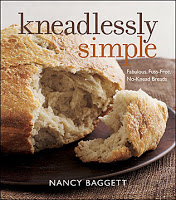 This is a wholesome, hearty, but not heavy boule that’s both flavorful and astonishingly easy to make. Besides being completely “kneadless,” as the photos show the raised dough is simply scraped from a bowl into the preheated pot–which automatically does all the shaping for you. This is a unique feature of many Kneadlessly Simple rustic pot breads and dramatically reduces the usual kitchen muss and fuss associated with most bread making.
This is a wholesome, hearty, but not heavy boule that’s both flavorful and astonishingly easy to make. Besides being completely “kneadless,” as the photos show the raised dough is simply scraped from a bowl into the preheated pot–which automatically does all the shaping for you. This is a unique feature of many Kneadlessly Simple rustic pot breads and dramatically reduces the usual kitchen muss and fuss associated with most bread making.
Makes 1 large loaf (about 2 pounds), 12 to 14 slices.Interested in whether “kneadless” bread is a passing fancy or here to stay–survey results here reveal some interesting answers
If you lack a suitable bread pot, but are in the mood for “kneadless” bread, check out my cheddar and chiles loaf.
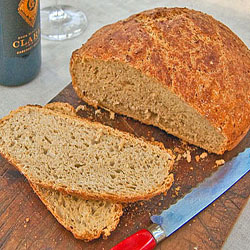
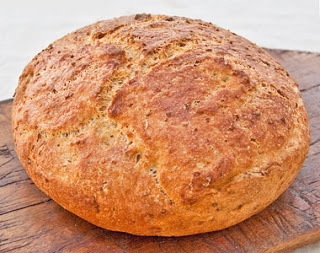

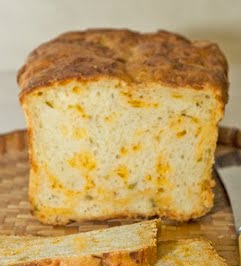

I’m not certain because I haven’t tried it, but I think you will have to stiffen the dough with some extra flour before the second rise. I suspect that it will just spread too much if not contained in a pot or stiffened. Yes, you could probably let it rise on parchment, then slide it in with a peel. So delighted to hear you like the book so much 🙂
Hi Nancy, I have enjoyed using your book since 2010. I am very happy making the olive rosemary and walnut bread recipes. I always use one half whole grain flour and one half all purpose and the results are terrific. I use a $35 Ikea cast iron pot for the baking and results are fine.
I have just acquired a 2cm black granite baking stone for use with pizza doughs. I’d like to make a round boule and try baking it freestyle on the stone. Most of your Boule recipes require plopping the dough into the hot pot. Which would be the best to shape the ball sized loaf and rise it (on parchment paper or?) then slide it with my Pizza peel onto the 400 degree heated baking stone into my oven? I would have the pan of icewater under the baking stone to provide the necessary steam for the early stages of baking. LOVE YOUR BOOK!!! have told all my baking friends about it.
Thanks, Mary, I had not thought of that. I don't normally make my own yogurt, but I could save the whey that collects on top of the plain yogurt I use. I have also actually used a little plain yogurt in several breads–it produces a very nice loaf.
I have been doing bread like this since I read the NY times article on bread without kneading. I love it. You might try using whey in the making of the bread instead of water. I make my own yogurt and the left over whey makes wonderful bread.
I meant to add that we have Nancy's book available and it includes a $10 coupon for a future Clay Coyote purchase, or $10 of if you order a pot with the book. http://bit.ly/kneadlesslysimple
Thanks for giving our No-Knead baker a try, Nancy. We love the recipe and the bread. For those who haven't tried it, it makes the perfect french toast, too!
The Clay Coyote Baker can also be used as a standard casserole, also.
http://bit.ly/zy7dG7
Marcia, thanks for stopping by–perhaps we will meet in person some day. Yes, the book is great for the "bread challenged!" But at the same time delivers very good quality. I hope you'll try it.
I have tried the oat bread from your book that Don had when we got married 2 years ago….delicious. This looks like something I could try, since I am bread making challenged! Marcia Reinoehl
Deeba, I was also amazed that their bread pot was so reasonably priced–I think their catalog says about $50! This is less than even a semi-nice enamel coated metal pot. I think I'm going to start giving them as gifts to the other no-knead bread bakers in my family.
I love the look and feel of the bread…full of rustic goodness nancy. That clay pot is to die for. I love the ease and flavours of No Knead bread, and this one looks exceptional!
Dena, it wonderful to hear that my book got you started with yeast baking–that is exactly what I hoped would happen. So many people are hesitant to try it, and this method makes it pretty foolproof.
Jamie, I didn't go into all the details in the post, but the good color and flavor result from the method. It calls for starting with ice cold water (called delayed first fermentation), and the dough rises very slowly over a long period. This encourages enzyme activity that improves taste, texture and crust color. Incidentally, the self-knead approach was the way bread was made before peeps discovered kneading.
The bread is gorgeous, perfect texture and the color does make it look flavorful; the perfect boule to go with a bowl of soup or a salad lunch. And the clay pot is really beautiful. This was an interesting and informative post, Nancy, and now I want to go out and check out clay cooking and baking pots. Really a pretty way to serve bread – and I have been making more no-knead bread lately. I need to find your book!
I got your Kneadlessly Simple book for Christmas and my first bread recipe ever was the Easy Pot Boule. It was easy, even though I messed it up in the beginning. I also ended up using too wide of a pot and the bread baked thin. Instead of a being round and soft, it was chewy and not very deep. We turned them into "breadsticks" and it worked just fine. I can't wait to try another pot boule again!